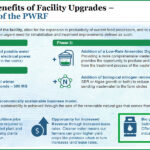
Ted Niblock
BioCycle February 2016
Environmental Justice is the notion that underserved and underrepresented communities should stop suffering disproportionately from environmentally hazardous activities. Biogas plays a key role in advancing Environmental Justice (EJ), and the industry should be proud of its potential to help rectify this longstanding problem.
My first direct experience with EJ was many years ago, when I worked for a renewable energy company siting a large facility in a rural area. Unbeknownst to us (and, I genuinely believe, to them) the county we were working with had suggested a site right on the county line, upwind from the next county which had a large number of underserved minority communities in the immediate area. We were appalled when we discovered this, and immediately sought to change the location, while also working with community leaders to make sure everyone knew this had not been intentional.
Environmental injustice is widespread and pernicious. The most public and tragic recent example is the water quality crisis in Flint, Michigan, and many experts have noted that, sadly, abysmally polluted water is widespread in poor communities across the country. What is outrageous is that these communities are the least well equipped to deal with the short term pollution crises and the long term health effects of toxic exposure.
In addition to bad water, many low income communities also have heavily polluted air. Power plants, refineries, and other instruments of our fossil fuel dependence are often situated close to the most vulnerable communities. Fortunately some real progress is being made on this front, most notably in the form of the Environmental Protection Agency’s Clean Power Plan, which, by limiting carbon pollution from power plants, will close many of our oldest and dirtiest coal plants. Relieving underserved communities of these emissions will help prevent thousands of premature deaths, and reduce the severe heart and lung damage and disease that come from living next to a giant coal fire.
The Executive Order that creates the Clean Power Plan directs the EPA to make EJ a part of its goal. (On Feb. 10, the U.S. Supreme Court granted an injunction against the Plan due to underlying lawsuits that must be resolved by a lower court.) The Plan contains measures that prioritize lessening the burden placed on vulnerable communities from pollution and ensure that these communities are not disproportionately affected.
The global effects of climate change are also going to cause widespread injustice, as increased temperatures, sea level rise, changes in precipitation, and more frequent or intense extreme events threaten basic needs such as food, water, health and shelter. This will most harm those who can withstand the least, such as native and tribal groups, and low-income populations. Climate change will also threaten regional political stability, again in the parts of the world where this is already challenged. Often, tragically, this existing instability stems directly from the realpolitik of the global fossil fuel market.
Biogas Benefits
Biogas is an important part of the solution to these problems. It is particularly well suited to advance the progress of EJ because it has the dual advantages of waste diversion and distributed renewable energy creation.
Waste is everywhere, and being disposed of everywhere, and if siting concerns can be apportioned fairly then all communities can benefit from beneficial use and improved handling of waste. To the extent that landfills, transfer stations and waste combustion plants have historically been located with unfortunate consequences to EJ concerns, diverting waste from those landfills and reducing reliance on legacy sites can only help. To the extent that future landfill (and waste combustion) siting risks repeating the mistakes of the past, diversion reduces demand for disposal capacity and lessens the number of difficult decisions to make.
While accruing this waste diversion advantage, biogas creates renewable energy from distributed generation, hastening decommissioning of fossil fuel electric plants located in underserved neighborhoods, and reducing the need for additional grid infrastructure. High voltage transmission lines and substations are not particularly onerous, but do still end up in low income and minority areas at a suspiciously high rate. Pipelines and rail cars carrying fossil fuels through these neighborhoods pose real and well known hazards of the highest order.
Biogas is also very effective as a climate change mitigation solution, since it not only displaces fossil energy, but also captures methane and other greenhouse gases which the waste would otherwise emit. Biogas is beginning to be deployed effectively in the developing world, where waste management is very challenging, electric grids are unreliable and expensive, and distributed generation can serve remote areas. As modern agriculture and new population centers grow in these regions, biogas can embed sustainable waste management solutions from the beginning.
Like any development activity, biogas needs to be mindful of environmental justice concerns. But with a small amount of effort, it can create projects that only help, and contribute greatly to the cause of reducing the harm being done to the communities least able to cope.
Ted Niblock develops biogas projects for NewAg Development.













